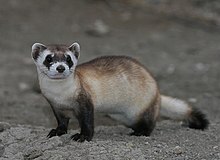
Back ابن مقرض أسود الأقدام Arabic ابن مقرض اسود الاقدام ARZ Ebeltanugaf Telibol (Mustela nigripes) AVK قارا آیاکلی گلینجیک AZB Чернокрак пор Bulgarian কালো পা ফিরেট Bengali/Bangla Pudask pavioù du Breton Turó de peus negres Catalan Mustela nigripes CEB Tchoř černonohý Czech
| Black-footed ferret | |
|---|---|

| |
| Scientific classification | |
| Domain: | Eukaryota |
| Kingdom: | Animalia |
| Phylum: | Chordata |
| Class: | Mammalia |
| Order: | Carnivora |
| Family: | Mustelidae |
| Genus: | Mustela |
| Subgenus: | Putorius |
| Species: | M. nigripes
|
| Binomial name | |
| Mustela nigripes | |
| Synonyms[2][3] | |
|
Putorius nigripes Audubon and Bachman, 1851 | |
The black-footed ferret (Mustela nigripes), also known as the American polecat[4] or prairie dog hunter,[5] is a species of mustelid native to central North America.
The black-footed ferret is roughly the size of a mink and is similar in appearance to the European polecat and the Asian steppe polecat. It is largely nocturnal and solitary, except when breeding or raising litters.[6][7] Up to 90% of its diet is composed of prairie dogs.[8][9]
The species declined throughout the 20th century, primarily as a result of decreases in prairie dog populations and sylvatic plague. It was declared extinct in 1979, but a residual wild population was discovered in Meeteetse, Wyoming in 1981.[10] A captive-breeding program launched by the United States Fish and Wildlife Service resulted in its reintroduction into eight western US states, Canada, and Mexico from 1991 to 2009. As of 2015[update], over 200 mature individuals are in the wild across 18 populations, with four self-sustaining populations in South Dakota, Arizona, and Wyoming.[1][11] It was first listed as "endangered" in 1982, then listed as "extinct in the wild" in 1996 before being upgraded back to "endangered" in the IUCN Red List in 2008.[1] In February 2021, the first successful clone of a black-footed ferret, a female named Elizabeth Ann, was introduced to the public.[12]
- ^ a b c d Belant, J.; Biggins, D.; Garelle, D.; Griebel, R.G. & Hughes, J.P. (2015). "Mustela nigripes". IUCN Red List of Threatened Species. 2015: e.T14020A45200314. doi:10.2305/IUCN.UK.2015-4.RLTS.T14020A45200314.en. Retrieved February 8, 2022.
- ^ "Mustela nigripes (Audubon and Bachman, 1851)". Integrated Taxonomic Information System. Retrieved May 10, 2024.
- ^ "Mustela nigripes (Audubon & Bachman, 1851)". Global Biodiversity Information Facility. Retrieved May 10, 2024.
- ^ Heptner, V. G. (Vladimir Georgievich); Nasimovich, A. A; Bannikov, Andrei Grigorovich; Hoffmann, Robert S. (2001). Mammals of the Soviet Union Volume: v. 2, pt. 1b. Washington, D.C. : Smithsonian Institution Libraries and National Science Foundation.
- ^ Coues 1877, p. 151
- ^ Cite error: The named reference
r39was invoked but never defined (see the help page). - ^ Cite error: The named reference
r61was invoked but never defined (see the help page). - ^ Cite error: The named reference
r13was invoked but never defined (see the help page). - ^ Cite error: The named reference
r36was invoked but never defined (see the help page). - ^ "Timeline". Blackfootedferret.org. Black-footed Ferret Recovery Implementation Team. Archived from the original on February 19, 2021. Retrieved March 18, 2021.
- ^ McLendon, R. (2011). "Rare U.S. ferret marks 30-year comeback". Mother Nature Network. Archived from the original on May 9, 2015. Retrieved October 9, 2011.
- ^ Cite error: The named reference
Peoplewas invoked but never defined (see the help page).
